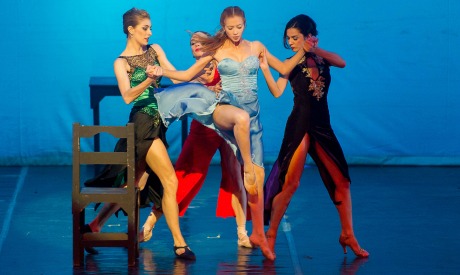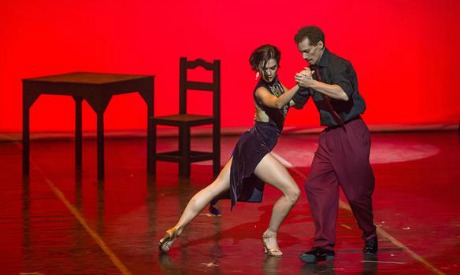Tango, the dance of passion, remains one of the most visually attractive performance art forms which celebrates the body in the most direct, sincere and sensual ways. It impresses the viewer with its dynamism, improvisation and unique technique. Originally from Argentine (and Uruguay) – no wonder – tango awes audiences across the world, and creates a special imprint in the hearts of both music and dance aficionados.
Once again, the great tango of Argentina returned to Egypt between 9 and 12 February (at the Cairo Opera) and again on 15 and 16 February (at the Alexandria Opera) when Nadia Muzyka, the principal dancer of Buenos Aires’s famed Teatro Colón and her troupe performed a show entitled Ballet Tango, Buenos Aires.
A graduate of the Higher Institute of Art Teatro Colón, today Muzyka is a widely acclaimed artist in Argentina. She has also worked with renowned choreographers and ballet masters around the world. Apart from the leading roles she performed in ballets such as Giselle, Don Quixote, Romeo and Juliet, The Nutcracker, Paquita, Cinderella and Swan Lake, among others, Muzyka is also known for her take on the Argentine tango, in which she merges this dance form with her classical background. The show, which relied on a recorded music by Astor Piazzolla, was choreographed by Julian Galvan and Magdalena Cortes, also dancers in the show.
According to May Selim’s note in Al Ahram Hebdo last week, the same show premiered recently in Vienna, Austria, under the different title, The Deadly or Rather Fatal Sins. “The show is a choreographic approach to the seven deadly sins: lust, greed, avarice, laziness, anger, envy and arrogance. The dancers represent those sins. Each has its own personality, costumes and colours,” Muzyka commented in this interview.
To stress the distinctions between the sins, the seven characters-dancers, four women and three men, were each dressed in a distinctive colour, with Muzyka in red. The show is devoid of scenography, relying on only a few props in form of tables and chairs. Even the lighting technique emphasises the colours by lighting the screen upstage in a colour represented by a dancer. For instance, when Muzyka dances in her red dress, she does so against the backdrop of a red screen, or when a blue character performs, again, the screen turns to the same colour.
In short, the Ballet Tango, Buenos Aires (or The Deadly or Rather Fatal Sins) is a collection of scenes-emotions. If we look for traditional structure, we won’t find it, as the show does not have any solid dramaturgy in which the narrative elements have a place or a purpose and link the scenes together. It is rather a run through a collection of visually captivating numbers that form an over one hour-long sequence depicting a range of emotions wrapped in colours.
Naturally, due to the dancers’ background, the whole show relied on a presentation of ballet skills, where the impressive grand jetes and clear pirouettes were the main vocabulary. The choreographers fused classical ballet with tango figures and stylings, striking poses and typical tango legwork. The final result was a creative amalgam performed by very skilful, and as their biographies reveal, accomplished dancers.
For more demanding audiences, live music, instead of recorded, would have added an intimate and rewarding feel to the show. And though we may also raise questions about format and sequence, this does not take away from the artistry and precision of each individual scene, from solos to duets to group dances.
Most important, however, is the fact that Ballet Tango, Buenos Aires was yet more proof of the tango’s eternal power. Let us not forget that through over a century, tango has experienced many adjustments and readjustments, it moved from the intimate dance embraces in Buenos Aires and Montevideo’s bars and streets, which did not have big stages, fancy lights and scenography onto the Europe’s ballrooms and soon after to dance competitions where the ostentatious factor steals the show; many leading world-class dancers merged chosen elements from tango’s fascinating vocabulary with their fields of expertise.
And even if, in the endless creative experimentation, tango’s numerous offsping have always found both supporters and opponents, most of the time, the multilingual component of tango manages to capture the international audience’s hearts. In Cairo’s performances, the show was rewarded with strong applause.

(Photo: Bassam Al Zoghby)
Argentina: Egypt's frequent visitor
To Egyptian audiences, Argentina and Latin America in general are among the most sought after evenings and they constitute a substantial part of the yearly music and dance programming. Starting at the top of the list, we can point to the Cairo Symphony Orchestra which often includes works by Argentina’s renowned composers, Alberto Ginastera and Astor Piazzolla among them, often placing them in evenings dedicated to Latin America.
In terms of dance performances, the magic word is precisely ‘tango’ and once it appears on posters and banners, the hall fills up. Quite recently (in January 2015), A Puro Tango, a company consisting of professional dancers with Argentine and Colombian backgrounds -- most of them champions of the tango competitions held in their respective countries -- brought Buenos Aires to the Cairo Opera with a show titled Life and Feelings. The show was a series of dance numbers interlaced with songs by David Gutierrez Ramirez. A small live band, which included a few bandoneon players, added a unique flavour to the evenings.
Another take on tango came to Egypt with the Inaki Urlezaga’s Ballet Concierto, a troupe which fuses ballet steps with tango and other dance forms, and which has been among the Opera’s returning guests. Similarly to Muzyka, Urlezaga’s background is in classical ballet, as he performed many lead roles at the Royal Ballet of London and the Dutch National Ballet. Urlezaga’s fusion however leans towards fusing the ballroom formats with traditional tango.
Along the same lines, one of the captivating repertoire elements of the Cairo Opera Ballet Company is Tango Rêve (Tango Dream), a short ballet work to music by Astor Piazzolla choreographed by the American-born but French-hearted Joseph Russillo. The long biography of the choreographer includes cooperation with Piazzolla himself, which resulted in works that merge different dance techniques, from classical ballet to jazz, with tango. In Egypt, Tango Dream is often the opening segment of an evening which brings together a few short ballets such as Danses qu’on croise, based on Brahms’ Hungarian Dances with Thierry Malandain’s choreography and Ravel’s Bolero with Maurice Béjart’s choreography.

(Photo: Bassam Al Zohgby)
This article was first published in Al Ahram Weekly
For more arts and culture news and updates, follow Ahram Online Arts and Culture on Twitter at @AhramOnlineArts and on Facebook at Ahram Online: Arts & Culture
Short link: